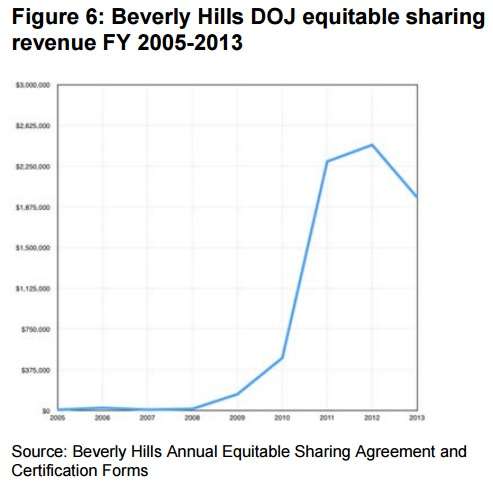Tiny California Towns Have Big Asset Forfeiture Histories
New report shows municipalities bolstering ailing budgets with seizures.


The Drug Policy Alliance has a big new report out today showing how a pack of small cities in Southern California are using and abusing the federal civil asset forfeiture program to get more money for their departments in the wake of budget woes. The report, researched and written by drug policy journalist Jonah Engle, also shows how little oversight the Department of Justice actually demonstrates over municipal and law enforcement forfeiture behavior that appears to violate guidelines for participation in the program.
What do the cities of Vernon, Baldwin Park, Beverly Hills, Gardena, Irwindale, La Verne, Pomona, and South Gate have in common? They're all comparatively small cities in Los Angeles County ranging in population from just 112 (Vernon) to 149,058 (Pomona). Yet these cities, combined, have collected more than $43 million in asset forfeiture between 2006 and 2013, according to the report. That's 60 percent more than the Los Angeles Police Department took in during that time frame, even though these combined municipalities still have only a fraction of the population of Los Angeles. The report breaks it down even further to help readers grasp the differences. Irwindale has a population of 1,422 people and has collected more than $800,000 in forfeited assets. Bakersfield has a population of 349,000 but collected only $571,796 during the same time. Vernon isn't even so much a city as it is a large industrial hub with a history of corruption. Despite having almost no residents, it brought in nearly $1 million in federal asset forfeiture funds during this time.
These forfeitures and the partnerships between municipal police and federal agencies rose as the economy of California slid into a slump. Forfeitures through the federal Equitable Sharing Program have tripled while forfeitures using the state's process have remained flat (and much lower). The reason is pretty simple: California's asset forfeiture law allows law enforcement agencies to keep only a maximum of 65 percent of the money they seize. The federal program allows law enforcement agencies to keep 80 percent. There's just more money in turning to the feds and ignoring the state. This has been a consistent problem with efforts by states to reform their asset forfeiture laws to make them less open to abuse or corruption. Law enforcement agencies just turn to the Department of Justice, with its looser rules, instead.
But, the report notes, municipalities don't appear to be abiding by Department of Justice regulations. Some cities appear to be anticipating forfeiture revenue in advance and using forfeited funds to supplant budgeted spending for law enforcement agencies. This is a no-no. Cities aren't supposed to be expecting a certain amount of asset forfeiture funds:
In fiscal year 2010, the Vernon Police Department made $186,072 in federal DOJ forfeiture revenue, only to have its budget cut the following year by $185,378. In fiscal year 2012, the Irwindale Police Department made $287,874 in forfeiture revenue; its budget was cut the following year by $285,658.
In fiscal year 2010, La Verne Police Department made $369,954 in DOJ forfeitures; the next year its budget was cut by $331,771.

The outcome is obvious in Beverly Hills, where 44 percent of their forfeiture funds went to pay for police overtime. The report notes that the Beverly Hills Police department budget was cut by almost $4 million in 2010. The next year, the department's federal forfeiture revenues more than quadrupled. Half of the asset forfeiture revenue for La Verne went to either salaries or overtime for police.
Expecting a certain amount of forfeiture revenue and replacing budgets with forfeited money obviously creates huge incentives for police to look for reasons to seize. The report also finds these cities frequently didn't have good recordkeeping of their forfeiture or had large discrepancies in different records.
There are consequences for the citizens of these communities from these shifts. Cities have cut police staff due to budget woes, affecting response times to calls. Then, some police departments shifted some of their remaining staff over to work on asset forfeiture, leaving even fewer officers to help citizens. South Gate cut 11 officers but increased staff assigned to asset seizure from two to four.
La Verne cut 20 percent of its police force between 2006 and 2014 but increased the size of its drug task forces. With this increased task force, they've turned asset forfeiture into a well-oiled machine, paying confidential informers (with money from previous forfeitures) for tips for drug deals, waiting for the drug deals to actually happen, then arresting all the suspects and seizing the money from the deals, which they then use to pay their own salaries and fund the tipsters for the next arrests.
And these forfeitures aren't even necessarily originating from criminal actions within these cities. Thanks to multi-jurisdictional police task forces, representatives from city police departments can participate in drug interdictions in other cities and bring home some of the money. That helps explain how a community like Vernon, with virtually no residents, gets so much asset forfeiture money.
Read the full report here (pdf). The report starts with the history and background of the federal Equitable Sharing Program and civil asset forfeiture in general before focusing on California cities in the second half.
All of these problems cited in the report are a prologue to California State Sen. Holly Mitchell (D-Los Angeles) introducing legislation for additional reforms to the state's asset forfeiture laws. In a press teleconference this morning she said her goal wasn't to eliminate asset forfeiture entirely but to make sure law enforcement operates under state guidelines, not the looser federal rules. "The problem is a dysfunctional system and inconsistent laws that create loopholes," she said.
Her bill, SB 443, would require criminal convictions in order to justify forfeiture actions within the state. Convictions are not currently not required for drug offenses or for seizures worth more than $25,000—instead the looser "clear and convincing evidence" of a crime threshold is used. It also requires that defendants in forfeiture cases be provided counsel if they can't afford it (funded by a percentage of recovered asset forfeiture money) and that defendants' attorneys have the ability to recover fees if they win. It also prohibits law enforcement agencies in California from transferring what they've seized to the Department of Justice to "adopt" to bypass state law and requires any forfeited funds law enforcement agencies get from the Department of Justice to be distributed according to state law. This means, no matter how local law enforcement agencies approach asset forfeiture, they will have to meet California's threshold of conviction and will only be allowed to keep the percentage of assets the state permits.
Her law has the backing of the Drug Policy Alliance, the American Civil Liberties Union, and the Institute for Justice.
Diane Goldstein, a police veteran and executive board member for Law Enforcement Against Prohibition (LEAP) spoke at the press teleconference on the experiences of both law enforcement officers and citizens dealing with a complex, easily abused system. When asked how municipalities would deal with the potential losses of these windfalls that have replaced smart budgeting, she said cities are going to have to have "a big educational moment," and the federal government, should it wish to continue helping fund local police, may have to look more toward grants than the forfeiture sharing program.
"Civil asset forfeiture was never intended to supplant law enforcement budgeting," she said.


Show Comments (16)